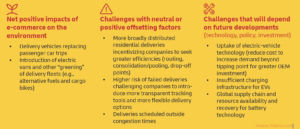E-commerce is fundamentally changing approaches to supply chain sustainability in the US, according to research published by DHL. A new white paper “ECO-mmerce: How online retail can build the sustainable supply chain of tomorrow” argues that the rapid growth of e-commerce is bringing immediate opportunities to reduce emissions within the supply chain while also challenging retailers, logistics providers, and policy-makers to collaborate and innovate to address the risks of climate change.
A DHL/Morning Consult survey of US consumers in May 2021 found that more than half of respondents (54%) indicated their online shopping habits increased during the COVID-19 pandemic, while the majority (60%) said they are willing to pay more for environmentally friendly products or services. 54% stated they put more trust in a company based on public commitments to environmental sustainability with carbon emissions, green energy, waste, alternative fuels, and sustainable packaging identified as the five most important factors in helping the environment. The survey results reflect the influential role that supply chain sustainability will play in the competitiveness of e-commerce businesses in the future.
DHL’s white paper looked in detail at the five segments of the e-commerce supply chain that are most exposed from a sustainability perspective: the last-mile, first and mid-mile, warehousing, packaging and returns.
The paper highlighted that the greatest impact is likely to be derived from three key areas of focus: cleaner energy, through more electrification of transportation fleets and warehousing operations; increased efficiency, supported by data and technology; and eco-friendly materials, particularly in packaging.
E-commerce and impact on the environment
E-commerce is already having a net positive impact on the environment compared to traditional retail in a number of areas, such as replacing multiple passenger car trips with single round trips with delivery vans and accelerating investments in greener transport and warehousing technologies. In other areas, the potentially negative impact of some trends, such as a proliferation of smaller warehouses closer to customers, is being offset by other effects such as the optimization of retail networks and the introduction of greener energy supplies and automated equipment.
The white paper also addresses areas, such as aviation, electric vehicle charging infrastructure, and packaging that will likely require further technological innovation or support from policymakers in order to totally eliminate emissions.
“E-commerce is fundamentally reshaping our customers’ supply chains, challenging them to redesign their transportation and warehousing networks in order to accommodate customer demand across multiple channels, address changes in trade and inventory flows, and be more responsive to the market,” said Kraig Foreman, President of eCommerce, DHL Supply Chain North America. “At the same time, we at DHL Supply Chain see this as a historic opportunity to build more sustainable supply chains from the bottom up, by reengineering processes with efficiency and emissions reductions in mind, taking advantage of new, greener technologies at all stages of the order cycle and exploring innovative ideas in areas such as packaging and the circular economy.”
Save time and mileage in last mile
Approaches that are in use today that save time and mileage over the last mile include:
- Deliveries that shift traffic to off-peak times and allow for the use of bigger trucks to reduce the number of trips.
- Route optimization that finds the best way to get from point to point and reduces dwell times at fulfillment centers.
- Load pooling that automatically matches the demand for capacity with available supply to maximize vehicle loads. This could potentially also include crowdsourcing via ridesharing and freight delivery platforms.
- Consolidated drop-off points at stores or parcel lockers where customers can pick up packages at any time, which also reduces the number of failed deliveries.
- Advances in autonomous vehicle solutions in which fuel efficiency increases when there is no human intervention. When paired with EV solutions, these types of deliveries could be extremely sustainable.
Fleet owners are recognizing there is unlikely to be a “silver bullet” solution that addresses all transport modes and markets with electrification, and there are still unknown factors and tradeoffs that need to be analyzed, such as the environmental impact of EV batteries over their entire life cycle, from sourcing to recycling/disposal. They are also incorporating alternative fuels like propane and biodiesel to reduce the consumption of diesel. In dense urban areas, companies are testing cargo bikes and scooters to reduce traffic congestion on crowded streets.
Source: DHL

